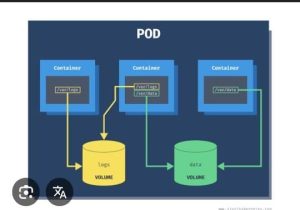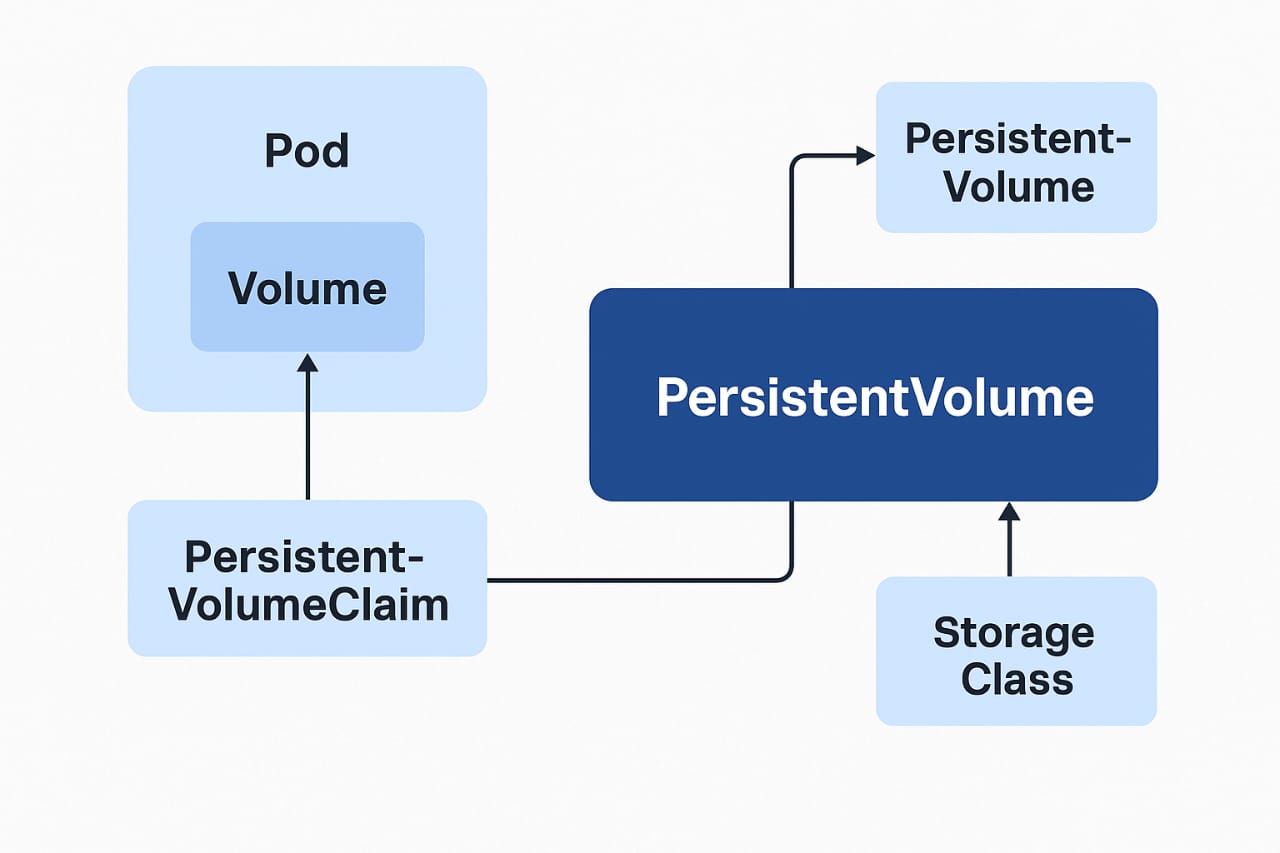What is a Kubernetes Volumes ?
Kubernetes Volumes are essential components in any containerized application where data persistence is needed. In this guide, you’ll learn about different volume types, use cases, and YAML examples to implement them. A Kubernetes Volumes is a directory accessible to containers in a Pod. It is used to store data that should be preserved across container restarts or shared among multiple containers.
While containers are ephemeral and their file systems are lost when they are restarted or terminated, volumes allow data to persist beyond the lifecycle of an individual container.

Uses of Kubernetes Volumes
Here are some key reasons to use volumes :
-
Persistence: Store data that must survive container restarts.
-
Data Sharing: Allow multiple containers in the same Pod to share data.
-
Decoupling: Separate application logic from data storage.
-
Flexibility: Choose from various storage backends (local, cloud, NFS, etc.).
-
Security and Isolation: Define access policies and security contexts.
Example
Here’s a simple example of how a volume is defined in a Pod YAML:
apiVersion: v1
kind: Pod
metadata:
name: simple-pod
spec:
containers:
- name: myapp
image: nginx
volumeMounts:
- mountPath: /usr/share/nginx/html
name: html-volume
volumes:
- name: html-volume
emptyDir: {}In this example:
-
The
emptyDirvolume is created when the Pod is assigned to a Node. -
The data in the volume is deleted when the Pod is removed.
-
The container mounts this volume at
/usr/share/nginx/html.
Types of Kubernetes Volumes
1. empty Dir
-
Use case: Temporary scratch space, cache, or intermediate files.
-
Lifecycle: Data is deleted when the Pod is removed.
volumes:
- name: cache-volume
emptyDir: {}2. hostPath
-
Use case: Mounts a file or directory from the Node’s filesystem into the Pod.
-
Caution: Can be risky as it ties the Pod to a specific Node.
volumes:
- name: host-volume
hostPath:
path: /data
type: Directory3. persistentVolumeClaim (PVC)
-
Use case: For persistent data storage backed by a
PersistentVolume. -
Decouples storage configuration from Pod specification.
volumes:
- name: my-pvc
persistentVolumeClaim:
claimName: my-claimYou must first create a PersistentVolume and a PersistentVolumeClaim.
4. configMap
-
Use case: Mount configuration files or key-value pairs into the container.
volumes:
- name: config-volume
configMap:
name: app-config5. secret
-
Use case: Store sensitive information like passwords, tokens, and keys.
volumes:
- name: secret-volume
secret:
secretName: my-secret6. nfs (Network File System)
-
Use case: Share volumes between Pods across different nodes.
-
Useful for legacy or shared network storage.
volumes:
- name: nfs-volume
nfs:
server: nfs.example.com
path: "/var/nfs"7. CSI (Container Storage Interface)
-
Use case: Use external storage drivers from vendors (e.g., AWS EBS, Azure Disk).
-
Highly extensible and recommended for production environments.
volumes:
- name: csi-volume
csi:
driver: ebs.csi.aws.com
volumeHandle: vol-abc123Volume Mounts
Each volume defined in the Pod must be mounted inside a container using volumeMounts.
volumeMounts:
- name: my-pvc
mountPath: /data-
mountPath: Path inside the container where the volume will be available. -
readOnly: Optional boolean flag to restrict writes.
Kubernetes Volume Lifecycle
The lifecycle of volumes varies depending on type:
| Volume Type | Persist After Pod Deletion? | Node-Specific? |
|---|---|---|
| emptyDir | No | Yes |
| hostPath | Yes | Yes |
| PVC | Yes | No |
| configMap/secret | No | No |
| NFS | Yes | No |
| CSI | Yes | No |
Security Considerations
It can lead to data leaks if not handled securely:
-
Set readOnly flag when appropriate.
-
Use RBAC to limit access to
Secrets,PVCs, andConfigMaps. -
Avoid using
hostPathunless absolutely necessary. -
Set SecurityContext to limit file system access.
StatefulSets and Volumes
When deploying stateful applications like MySQL, Kafka, or Redis, use StatefulSets with PVCs:
volumeClaimTemplates:
- metadata:
name: data
spec:
accessModes: ["ReadWriteOnce"]
resources:
requests:
storage: 1GiEach replica gets its own volume, preserving state independently.
Example:
Deploying WordPress with MySQL:
-
MySQL uses a PVC to persist database data.
-
WordPress also uses a PVC to store uploaded files.
Each volume ensures that even if the Pod restarts, the data remains intact.
Kubernetes Volumes: Architecture Diagram
+-------------------+
| Pod |
| +-------------+ |
| | Container A |--|---> /mnt/data (mountPath)
| +-------------+ |
| | Container B |--|---> /mnt/data (shared mount)
| +-------------+ |
| | |
| V |
| Volume (PVC) |
+-------------------+Best Practices for Kubernetes Volumes
-
Use PVCs and StorageClasses for dynamic provisioning.
-
For temporary data, prefer
emptyDir. -
Always define resource requests for storage (
storage: 1Gi). -
Monitor volume using tools like Prometheus and Grafana.
-
For multi-Node sharing, use
NFSorCSIwith proper backend support.
Final Thoughts
Kubernetes Volumes are a fundamental part of that allow your applications to handle real-world data storage needs. Whether you’re storing logs, database records, or cache files, Volume give you the flexibility, scalability, and reliability needed to run production workloads.
From emptyDir to PersistentVolumeClaims, understanding it will help you build more resilient and stateful applicatio
For official documentation, visit the click here
